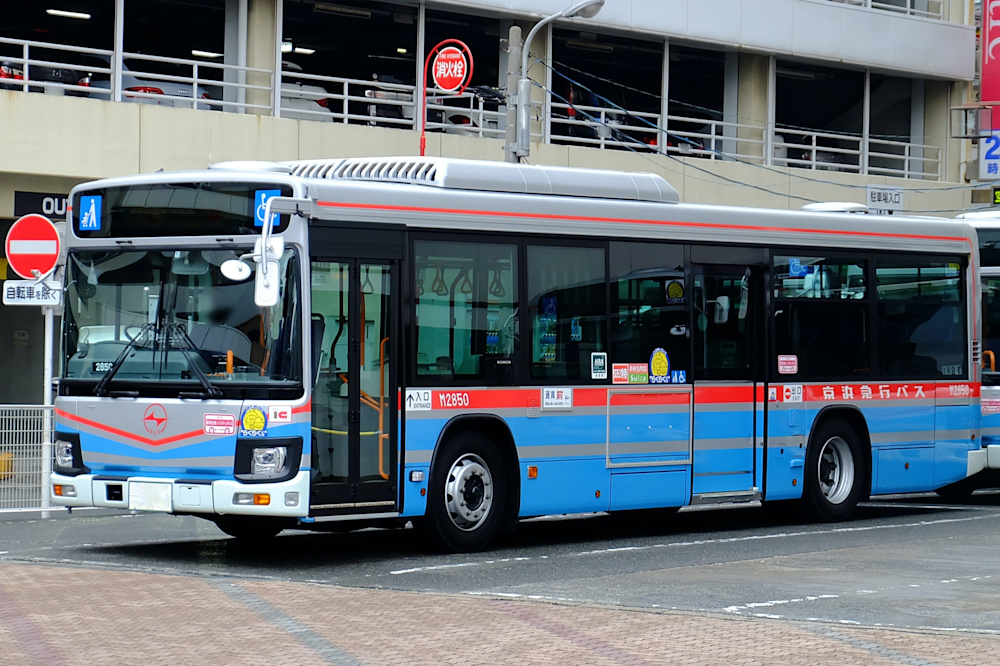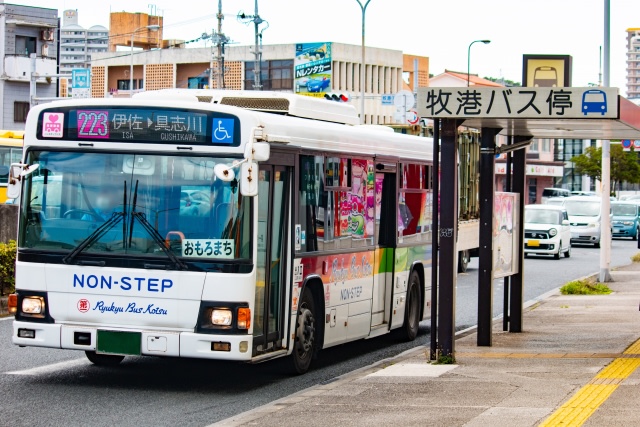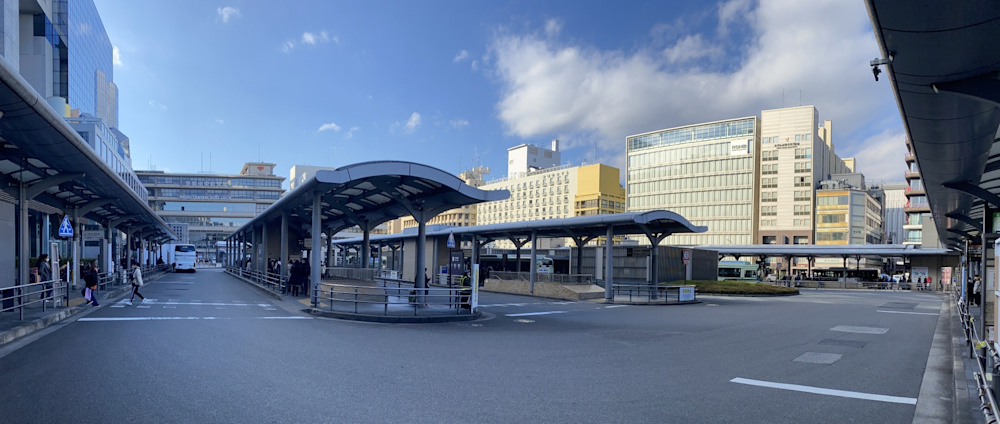Updated October 27, 2025
Taking the Bus in Japan: Your Complete Guide
Everyone talks about Japan's trains, but buses are equally vital for getting around, especially in cities like Kyoto where they're the main form of public transport.
Using the bus system is easy once you understand how things work. The payment methods are different from what you might be used to, and there are some unwritten rules worth knowing.
In this guide, we'll walk you through everything you need to know about Japan's bus system, from local and highway buses to night buses. By the end, you’ll know how to pay for bus in Japan and navigate the system like a local.
In this article: 📝
Understanding the Different Types of Buses in Japan
Japan has several distinct types of buses, each serving different purposes and operating under different schedules and rules.
Local Buses: Your Neighborhood Navigator
If you find yourself in Japan’s countryside (inaka), or even in suburban areas, you’ll quickly realize that the local buses handle most of Japan’s public transportation.
Buses operate on fixed routes within cities and towns, making regular stops as passengers request. These are the buses you'd use for work commutes, shopping trips, or visiting friends across town.
These buses typically run during daytime hours and follow set schedules, though traffic can sometimes cause delays. In major cities like Tokyo and Osaka, local buses complement the train network, but in places like Kyoto, they're often your best (or only) option for reaching certain neighborhoods and tourist spots.
Highway Buses: The Budget Traveler's Best Friend
Highway buses operate on expressways and connect major cities across Japan. They're slower than the Shinkansen but considerably cheaper, making them popular among travelers and locals on a tight budget. Routes range from short inter-city trips to cross-country journeys.
These buses come in different comfort levels, from standard seats to premium options with extra legroom. Many buses feature amenities like Wi-Fi, charging ports, and even onboard toilets.
If you're traveling between Tokyo and Osaka, for example, a highway bus might cost you 3,000-8,000 yen compared to around 13,000 yen for the bullet train.
Night Buses in Japan: Sleep Your Way Across Japan
Night buses are essentially highway buses that operate overnight on long-distance routes. They're a clever way to save both time and money: because you travel while you sleep, eliminating the need for a hotel room.
Because of the long distances, night buses typically have at least two drivers who alternate throughout the journey.
You can find basic economy buses with standard seating, mid-range options with more spacious seats, and even luxury buses with lie-flat seats, privacy curtains, and premium amenities.
Companies like Kanto Bus operate high-end services such as the Dream Sleeper, featuring individual sleeping compartments that rival hotel rooms.
On the other end of the spectrum, you’ll also find standard night buses that offer comfortable reclining seats at budget-friendly prices, perfect for travelers on a budget.
How to Use Local Buses: How to Ride Bus in Japan
Local buses might look confusing initially, especially since the boarding system changes by region, but they're actually pretty straightforward once you know the basics.
Getting On and Off
Getting on and off is fairly simple, but the process differs depending on where you are in Japan.
In many regions, you board through the rear door and exit through the front. However, in Tokyo and some other cities, it's the opposite: You enter through the front and exit through the back.
Watch what other passengers do when you're at a new location. Most buses have clear signs indicating which door to use, and you'll quickly notice the pattern once you're on board.
When your stop is approaching, simply press one of the buttons located along the sides of the bus or behind the seats. This signals the driver that you want to get off at the next stop. The bus will announce each stop (sometimes in English, but not always), so it helps to know the name of your destination in Japanese. You can also follow along with Google Maps.
Payment Options and Rates for Highway Bus Booking
How you pay for local buses depends on the system in place. In flat-fare areas, which are common in city centers like downtown Kyoto, you pay the same amount regardless of how far you travel. In distance-based systems, your fare increases the farther you go.
For flat-fare systems, you typically pay when boarding. Simple enough. For distance-based fares, however, it’s a bit more complicated.
When you get on, you first take a numbered ticket from a machine near the entrance that corresponds to your starting point. As the bus travels, a fare display at the front shows how much each ticket number owes. When you exit, you match your ticket number to the display and pay accordingly.
Payment methods include cash and IC cards like Suica or Pasmo. Newer buses in major cities even accept contactless credit cards, though you shouldn't rely on this option everywhere.
Some buses in rural areas don't have IC card readers, so it’s best to carry cash just in case.
If you're paying cash and don't have exact change, most buses have change machines that can break bills (usually up to 1,000 yen). That said, you can't use these to pay your fare directly; they only provide change.
Just keep in mind that the change machine and the payment slot are usually right next to each other. If you need change, insert your ¥1,000 banknote into the change machine, not the fare/payment slot. Otherwise, you’ll pay the ¥1,000 in full and won’t get any change back.

Important Things to Know About Local Buses
Finally, let’s look at a few tips that will make your local bus experience smoother.
First, buses don't always stop at every stop. If no one presses the button or waits at the stop, the driver might skip it. So, always press the button to signal your intention to get off, and if you’re waiting at the bus stop, stand in the front so the driver sees you.
Second, keep your bus ticket because you'll need to show it when paying. If you lose it, you might have to pay the maximum fare from the first stop on the route.
Lastly, larger luggage isn't typically welcome on local buses. Some companies ask passengers to limit their bags to 10 kilograms. If you're traveling with suitcases, consider using a taxi or luggage forwarding service instead. If you're arriving at Narita or Haneda airport, plan accordingly for your onward journey.
Navigating Highway Buses Like a Local: How To Take Bus in Japan
Highway buses operate differently from local buses, with more structured booking and boarding procedures.
Boarding and Exiting Procedures
Most highway buses have a single front door for both boarding and exiting, though some newer models have additional mid-bus doors.
Unlike local buses, where you might just hop on, highway buses often require you to show your ticket or reservation confirmation to the driver when boarding.
The bus typically has a large storage compartment underneath for bigger items, so you can bring suitcases and even sports equipment like skis or snowboards.
However, luggage policies vary by company and route, so check the rules when booking. Airport buses tend to have particularly strict limits on the number and size of bags allowed.
To exit, press the button once the driver announces your stop. Some routes make multiple stops, while express services might only stop at major destinations, so confirm your route beforehand.
Tickets, Reservations, and Payment
The ticketing system for highway buses varies by company and route. Some services operate on a first-come, first-served basis without reservations, while popular routes may require booking in advance.
You can purchase tickets in multiple ways:
Directly on the bus with cash or an IC card (for unreserved services).
At ticket machines at bus terminals using cash, IC cards, or credit cards.
Online through various booking websites.
Some companies also allow payment at convenience stores for certain ticket types.
Booking in advance often gets you better prices, especially if you're traveling during off-peak times or weekdays. Prices can vary significantly depending on demand, with weekend and holiday fares being typically higher.
Useful Booking Websites
The following English-friendly websites make booking highway buses very easy:
Willer Express - One of the largest operators with routes nationwide.
Japan Bus Online - You can book buses from multiple companies.
Highway Buses Japan - Comprehensive route search.
Kosoku Bus - Wide selection of operators.
Japan Bus Lines - Another multi-operator platform.
These sites let you compare prices, departure times, and bus types, so you can easily find the best option for your trip.

What Makes Highway Buses Special
Beyond the cost savings, highway buses offer some distinct advantages.
Unlike crowded commuter trains, you're guaranteed a seat, which makes for a more comfortable journey.
You're also allowed to eat and drink on board, as opposed to local buses where this is generally frowned upon.
Long-distance routes also make regular stops at highway rest areas where you can use facilities, buy snacks, and stretch your legs. These rest stops are often surprisingly nice, with clean bathrooms, convenience stores, and local specialty shops.
Last but not least, if you're looking into how to buy a commuter pass in Japan for your daily travels, remember that highway buses offer an alternative for longer but regular commutes between cities.
Night Buses in Japan: Everything You Need to Know
Night buses offer a unique alternative and provide some neat perks that daytime highway buses don’t.
Boarding and Luggage
Most night buses board through the front door, though some have mid-bus entrances or are double-decker models with different luggage capacity.
Two-level buses typically have less storage space than single-level ones since the luggage compartment is smaller, so keep that in mind.
Make sure you arrive at the departure point with plenty of time to spare. Arriving at least 20-30 minutes earlier is a good rule of thumb. Night bus terminals can be busy, and you'll need to find your bus among the many other buses.
Most night buses stop less frequently than local buses. To signal your departure, simply press the button after the driver announces the upcoming stop.
Booking and Payment for Bus Tickets Japan
Night buses require reservations, so you must book before departure. Some companies have cutoff times, like 24 hours before departure, so don't leave it to the last minute.
The same booking websites that work for highway buses also handle night buses:
Payment methods are the same as highway buses: Online by credit card when booking, or in person at convenience stores or ticket machines.
Making the Most of Your Experience: Overnight Bus in Japan
Night buses make multiple rest stops during the journey, typically every 2-3 hours. You can use this time to use the toilet, buy food and drinks, or just get some fresh air.
These stops at highway rest areas are brief, usually around 10-15 minutes, so pay attention to when the bus is departing again.
Most buses provide basic amenities like blankets, though some companies have reduced or eliminated these due to hygiene concerns since COVID. So, bringing your own small blanket or layer of clothing is a good idea to stay warm. Some premium services provide neat little amenity kits with essential travel items like eye masks, earplugs, and slippers.
The seating configuration affects the comfort level significantly. Basic buses have standard reclining seats in a 4-row arrangement (two seats on each side). Mid-range options offer 3-row seating with more space between seats. Premium and luxury buses might feature 2-row seating or even individual compartments with full privacy.
As of late, some night bus services in Japan have started offering even more luxurious sleeping experiences, with a “hotel-on-wheels” theme featuring individual sleeping pods.
Bus Etiquette Japan: How to Ride Respectfully
Understanding Japanese bus etiquette is about making the journey pleasant for everyone, including yourself. As an expat, showing awareness of these cultural norms shows respect and will help you integrate better into Japanese society.
If you're interested in broader cultural considerations, check out our guide on disrespectful things to do in Japan.
Noise and Phone Usage
Keep your voice down when talking to your travel companions.
Japanese buses are quiet spaces where people rest, read, or simply want peace. Speaking on your phone is especially frowned upon, so switch it to silent mode and avoid phone conversations entirely. If you must take an urgent call, keep it extremely brief and speak in a low voice.
If you're listening to music or podcasts, use headphones and keep the volume low enough that others can't hear it. Remember, what seems like a reasonable volume to you might be disturbing to the person sitting next to you.
Seating Considerations
Keep in mind that priority seats near the front of the bus are reserved for elderly passengers, pregnant women, people with disabilities, and those with small children. Even if these seats are empty and the bus is relatively uncrowded, it's best to leave them available.
Also, if you're seated in a regular spot and someone who needs the seat more boards the bus, such as an elderly or handicapped person, offering your seat is considered good manners.
On highway and night buses where seats are assigned, you'll be seated in your designated spot. However, if you need to recline your seat, especially on night buses, it's courteous to check with or inform the passenger behind you. A simple nod or gesture goes a long way here.
Food, Drink, and Personal Space
On local buses, it’s recommended to refrain from eating or drinking entirely. The smell and potential mess can bother other passengers in a confined space.
Highway and night buses are way more relaxed about this. You can have snacks and drinks, but be mindful when choosing them. Opt for snacks that don't have strong odors, and clean up any waste.
If you're carrying a backpack, hold it in front of you or place it on your lap rather than keeping it on your back, where it takes up extra space and might bump into other passengers. The same goes for shopping bags. Be sure to keep them close and compact.

General Courtesy and Safety: How to Ride Bus in Japan
Don't walk around after the bus starts moving. Wait until the bus comes to a complete stop before standing up to exit.
Also, keep track of your valuables. While Japan is generally very safe, it's still wise to keep your belongings close.
If you see someone who needs help, such as an elderly person struggling with bags or a parent with a stroller, offering assistance is appreciated, though some people may politely decline.
All in all, save intense conversations, eating messy food, or doing anything that might disturb or distract others for another time and place.
These small acts of consideration are central to Japanese culture and crucial to maintaining societal harmony.
Understanding these social norms will also help you better navigate Japanese business etiquette and corporate life, where respect and consideration are equally important.
Conclusion on How To Ride a Bus in Japan
Navigating Japan's bus system might feel overwhelming at first, but it quickly becomes second nature.
Local buses will get you around your neighborhood and help you explore areas trains don't reach. Highway buses offer an affordable way to travel between cities while enjoying the scenery. Night buses let you maximize your time and budget by combining transportation and accommodation into one.
As we conclude here, remember to always have some cash on hand for rural routes, keep your IC card charged for convenient payments in urban areas, and check the specific rules for the bus company and route you're using.
Just like knowing how to read your Japanese payslip can help you navigate work life, mastering the bus system helps you navigate Japan with ease.
Get Job Alerts
Sign up for our newsletter to get hand-picked tech jobs in Japan – straight to your inbox.








